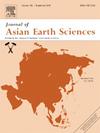Petrogenesis of Jurassic granitoids from the Yanshan orogenic belt: Implications for crustal evolution in the northern North China Craton
IF 2.7
3区 地球科学
Q2 GEOSCIENCES, MULTIDISCIPLINARY
引用次数: 0
Abstract
This study presents new geochronological and geochemical data for the Wangpingshi granite (WG) and Yuerya granite (YG) from the Yanshan orogenic belt, aiming to reveal their petrogenesis and source characteristics. Zircon U–Pb dating of the WG and YG plutons indicates formation ages of 171 Ma and 168 Ma, respectively. These granites are high-K calc-alkaline I-type granites, characterized by high SiO2 and low P2O5 contents, enrichment in Rb, Th, U, and Pb, depletion in Nb, Ta, Ti, and P, with low Nb/U, Nb/Ta, and Zr/Hf ratios. They exhibit initial 87Sr/86Sr ratios of 0.7045–0.7063, εNd(t) values of −12.28 to −11.36, and zircon εHf(t) values of −14.65 to −9.19. These geochemical and isotopic characteristics suggest that the granites originated from partial melting of a modified crustal source comprising both juvenile and ancient crustal components. Petrogenetic modeling indicates that the WG magma formed under pressures of 12.5–13 kbar with a garnet-bearing amphibolite residue, while the YG magma formed under pressures of 9–10 kbar with a plagioclase-dominated amphibolite residue. The source characteristics of the granites indicate that the lower crust underwent significant modification through magma underplating before the Jurassic, which likely weakened the crust and facilitated subsequent tectonic deformation. This research provides a lower age limit of 170–168 Ma for constraining the initiation of episode A of the Yanshanian Movement.
求助全文
约1分钟内获得全文
求助全文
来源期刊

Journal of Asian Earth Sciences
地学-地球科学综合
CiteScore
5.90
自引率
10.00%
发文量
324
审稿时长
71 days
期刊介绍:
Journal of Asian Earth Sciences has an open access mirror journal Journal of Asian Earth Sciences: X, sharing the same aims and scope, editorial team, submission system and rigorous peer review.
The Journal of Asian Earth Sciences is an international interdisciplinary journal devoted to all aspects of research related to the solid Earth Sciences of Asia. The Journal publishes high quality, peer-reviewed scientific papers on the regional geology, tectonics, geochemistry and geophysics of Asia. It will be devoted primarily to research papers but short communications relating to new developments of broad interest, reviews and book reviews will also be included. Papers must have international appeal and should present work of more than local significance.
The scope includes deep processes of the Asian continent and its adjacent oceans; seismology and earthquakes; orogeny, magmatism, metamorphism and volcanism; growth, deformation and destruction of the Asian crust; crust-mantle interaction; evolution of life (early life, biostratigraphy, biogeography and mass-extinction); fluids, fluxes and reservoirs of mineral and energy resources; surface processes (weathering, erosion, transport and deposition of sediments) and resulting geomorphology; and the response of the Earth to global climate change as viewed within the Asian continent and surrounding oceans.
 求助内容:
求助内容: 应助结果提醒方式:
应助结果提醒方式:


